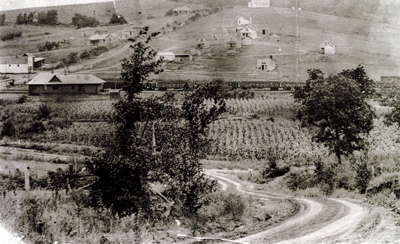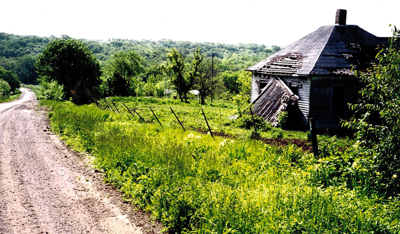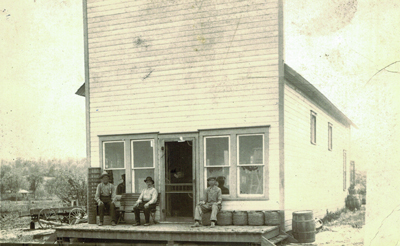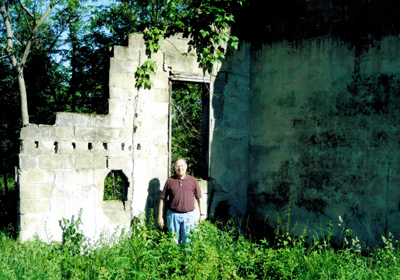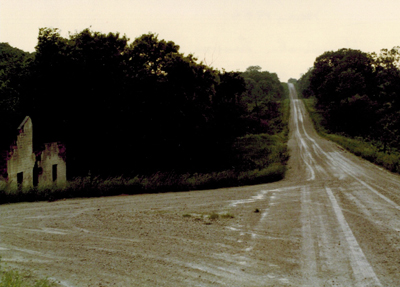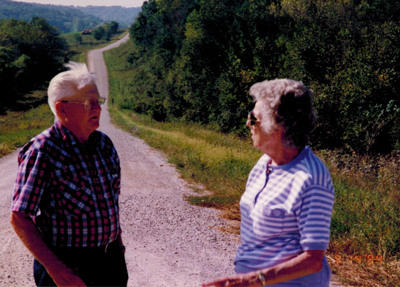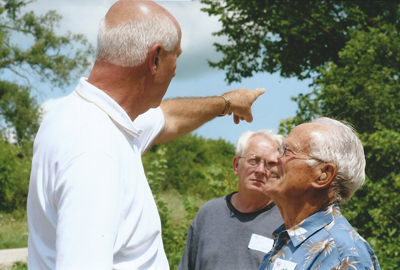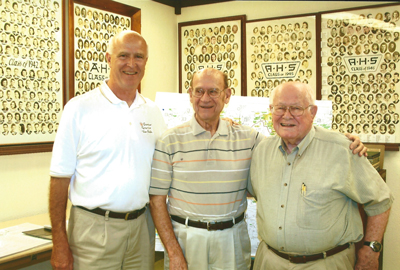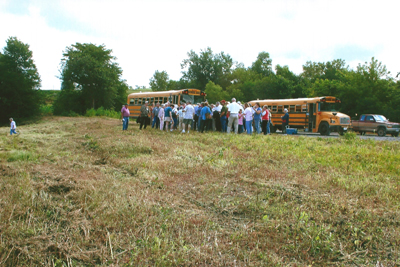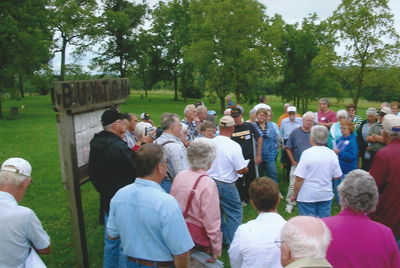
http://www.buxtoniowa.com • Consol, Haydock & Buxton Iowa, USA • 1871 - 2014
Live an afternoon in the Coal Camps
2009 Monroe County Sesquicentennial Coal Mining Camp Tours
“Live an afternoon in the Coal Camps” by Gordon Peterson
The Albia Union-Republican, July 16, 2009
Editors note: Gordon Peterson will be the tour guide for Bucknell, Haydock and Consol that will take place on Saturday, August 1st, 2009 from 2 to 4p.m. The tour is part of the activities scheduled for “Salute to Mining and Railroads’ weekend. Peterson is the grandson of David and Emma Peterson (Nylander), former owners of stores in the coal mining towns of Buxton, Coopertown, Consol and Haydock.
Come ride with us as we tour the Monroe County coal mining camps of Bucknell, Haydock and Consol that once housed nearly 5,000 miners and their families. The towns were built from the ground up and virtually closed after existing but a single decade from 1916-1927 when the miners went out on strike and the mines closed. Imagine if you will as we drive the Monroe County hills, a town once nearly the size of Albia that is now totally “Gone with the Coal Dust”. Only dense trees and heavy foliage now populate the land. We will travel Route 32 from Albia to Haydock with stops along the way- Hiteman, Consol, Mine Camp 18, Bucknell, Midway, Haydock and will end at Mine 20. These are camps that began after the Monroe County Buxton coal camp, 20 miles to the northeast, started closing in 1918, and the coal mines in the Buxton coal fields ran out of coal.
Our journey will include a swim in Whites creek as they did nearly 100 years ago. We will stand on what was once the railroad bed to Mine 18 and watch out for the huge train locomotives pulling coal cars full of coal. We will buy a ticket at Theodore Sampson’s Consol Movie House where we will watch our first ‘talkie” movie (the front facade of the theater is still standing) and we will say “Hello” to the Consol Post Master, Dave Peterson, at his store next to the movie theater (The store is now the North End Tavern in Lovilla). The Consol Post Office was in the front of Peterson’s store. As we leave Consol heading west we will wave to a black gentleman, Mr. Henry Bols, and his wife Minny working in their garden. The remains of their home have now tumbled to the ground. During our four mile ride from Consol to Bucknell we will pass the ice pond where blocks of ice were once cut each winter to be used during the hot summer days. After passing John Maddy’s farm and entering the bottom camp at mine 19, we look up the hills towards the west for two miles. What once was Iowa’s longest Main Street has houses and businesses of all kinds on both sides of the street. The roads were more like paths than roads.
We are now on the east end of the start of the towns of Bucknell, Midway and Haydock. Our driver gears down the bus to begin climbing the hills west on Route 32 (160th Street). Traveling west from Bottom Camp we can stop at Jack Williams Sr.’s pool hall and shoot a game or at Art Armstrong’s meat market (the ruins from the market are on the ground). The miners will be leaving Mine 19 washhouse after washing off the coal dust from their day in the mines (the brick washhouse is still standing). We are especially careful not to trip over the survey marker for the mine that Francis Butcher’s father Romeo Butcher placed when the town of Bucknell and Mine 19 were being built in 1918 . When we get to Midway, we will stop at the Peterson Store for a treat and fill up with gas as most everyone did over 90 years ago.The Peterson children are playing near the backyard creek and the store’s ice house( The brick walls of the Peterson home next to the store are still standing). From the Peterson Store we could choose to take the Melrose Road (527th Ave) south six miles south to Melrose and drive near where Mine 20 was to be opened (Mine 20 was sunk but never opened). Mine 20 was never mined due to the the miners going out on strike in 1927. The Superior Coal Company then closed mines 18, 19 and 20 for good. Instead of turning south, our driver continues west on Route 32.
As we reach Mine 20 Hill, we stop to watch the children getting out of the Bucknell School (rubble from the school still remains). We are careful not to fall down the cliff behind the school.Some of the children are walking from school across Route 32 on Baxter Street to play on the ball fields. Approaching the West end of Route 32’s Main Street in Haydock, we will stop at J.E. Larson’s store to see “What’s cooking.” If Tudy and Violet Blomgren are home next door we will say “Hello” and recall when Violet was a grade school teacher in the Bucknell schools nearly 100 years ago. If it were wintertime we could get on our sleds and slide back down Route 32 east all the way to the Peterson Store corner where we would turn south to slide on the Melrose Road and end at where the railroad bed to mine 20 crosses Melrose Road.
Our journey to Monroe County Coal Mining Camps on Route 32 ends at Mine 20, as it did for miners and their families. They left the coal camps when the mines closed in 1927. Monroe County’s Route 32 coal mining camps are not just memories- at least not to many of us. Our roots are there. To us they still are living coal camps.
Opinion Page “Loved the mining tours” by Gordon Peterson
Albia Union-Republican, Thursday, August 13, 2009
To the Editor:
As one of the tour guides on the August 1, 2009 tour of coal mining camps in Monroe County, I wish to thank the Monroe County Museum as well as the City of Albia and Monroe County for sponsoring and hosting the tours. I have been exploring and visiting my roots in your fair city and county for over 50 years. Over that period of time I have watched with great trepidation as many of the historic sites of the coal mining camps were destroyed and now cease to exist. As I like to say, “Gone with the Coal Dust.”
Over 200 citizens, many from Albia and Monroe County including Albia Mayor Richard Clark attended the two-day tours of Buxton, Haydock, Hocking and Hiteman. The response was excellent. Thanks to you good citizens the trend to destroy historical sites has been reversed. Buxton has taken on new life with the clearing of brush in downtown Buxton and the Buxton Cemetery. The Consolidation Coal Company’s store foundation has emerged from its grassy grave as has the foundation for the White House Hotel. Thanks to Jim Kreegel’s willingness to provide the land and allow for a rocked road access, “Old Buxton” is now there to be visited and reflected upon by those of us with our roots there or just for those who appreciate what once was the largest coal mining area west of the Mississippi.
There were visitors from California to Maine on the tours and those of us in between as my family and I live in Minneapolis/St.Paul. I mentioned to Mayor Clark on the tour that I feel there is a golden opportunity for developing coal mine camp tourism in your city and county. With a population that numbered 5,000-10,000 miners and their families once living in Monroe County coal mining camps, a whole lot of people over the USA have their roots in your Monroe County hills. Most are like me, they want to return to their family’s roots to reconnect, remember and appreciate how those generations before us lived and endured. I personally gain a perspective that is important to me in the changed world we now live in.
Gordon R. Peterson
Bloomington, Minnesota
“Museum Notes” by Rosalie Mullinix
Albia Union-Republican, August 4, 2009
To say the Museum was busy this past weekend is putting it mildly. The weekend started Friday as we opened at 9a.m. with our volunteers coming to see what needed to be finished up for the next day tours. Then we had a very full day of visitors which we are always happy to have.
Saturday morning, the Buxton tour buses filled up and a few people had to drive themselves and we appreciate them doing so. More people were already out at the Buxton site when the buses arrived.
We had over 250 people for the two days of tours. Carl Blomgren’s talk at 1p.m. was standing room only. Gordon Peterson and Byron Patrick, afternoon guides each had a bus full.
Hocking on Sunday was, also, a good tour with Ernie Corso telling historical facts of the town. After the tour, at the museum, he showed mining items to the crowd. Lots of stories passed between participants of the tour. A good time was had by all.
This weekend we will have pictures and items for the patriotism celebration. Join the celebration up town then come to the museum after it’s over. We’ll be open 1 to 4 p.m.
